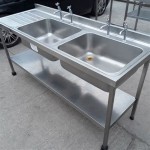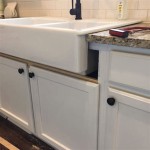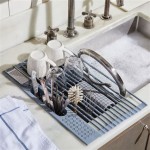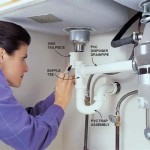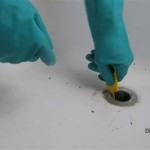Kitchen Sink Clogged: Troubleshooting a Garbage Disposal Issue
A clogged kitchen sink, particularly when tied to a garbage disposal, represents a common household problem. This inconvenience can disrupt daily routines and, if left unattended, potentially lead to more significant plumbing issues. Understanding the causes, implementing preventative measures, and learning basic troubleshooting steps are essential for homeowners.
Diagnosing a clogged kitchen sink linked to a garbage disposal requires a methodical approach. Initially, determining the source of the clog is crucial. Is the issue solely with the garbage disposal itself, or does it extend further into the drainpipe? A flooded sink basin serves as an immediate indicator of a blockage. The presence of unusual noises, such as grinding or humming, emanating from the disposal unit suggests a potential mechanical problem or an accumulation of debris preventing proper operation.
Safety remains paramount throughout the troubleshooting process. Before attempting any repairs or investigations, ensuring the garbage disposal is switched off at the circuit breaker is vital. This precaution mitigates the risk of electrical shock or accidental activation of the disposal blades during manual intervention.
Identifying Common Culprits of Garbage Disposal Clogs
Several factors contribute to garbage disposal clogs. Understanding these common culprits aids in both prevention and effective troubleshooting. One of the most frequent causes is the improper disposal of food waste. Certain materials are inherently unsuitable for garbage disposals, leading to blockages and potential damage.
Grease, fats, and oils solidify as they cool, adhering to the internal components of the disposal and drainpipes. This accumulation restricts water flow and traps other food particles, accelerating the formation of a clog. Similarly, starchy foods like pasta, rice, and potatoes expand when exposed to water. This expansion creates a dense, glue-like mass that readily obstructs the drainpipe.
Fibrous vegetables, such as celery, asparagus, and onion skins, pose another challenge. Their stringy nature makes them difficult for the disposal blades to effectively grind, resulting in tangled masses that impede the unit's operation. Coffee grounds, while seemingly innocuous, can accumulate in the drainpipe over time, forming a sludge-like substance that contributes to clogs.
Non-food items represent a significant source of garbage disposal problems. Utensils, silverware, small toys, and other foreign objects that inadvertently fall into the disposal can cause immediate blockages or damage to the blades. Even seemingly biodegradable items like fruit pits and bones are too hard for most residential garbage disposals to process effectively.
Insufficient water usage during disposal operation is also a contributing factor. Water acts as a flushing agent, carrying ground food particles through the drainpipe. When the water flow is inadequate, food debris tends to settle and accumulate, leading to clogs. Overloading the disposal with excessive amounts of food waste at once can also overwhelm the unit's capacity and contribute to blockages.
Step-by-Step Guide to Clearing a Clogged Garbage Disposal
When a kitchen sink clogs due to the garbage disposal, a systematic approach is necessary to effectively clear the blockage. The following steps outline a common troubleshooting procedure. Remember to always prioritize safety by disabling the power supply to the disposal before proceeding.
First, visually inspect the disposal unit. Remove any visible debris or obstructions using tongs or pliers. Avoid using hands to prevent injury from the blades. A flashlight may be helpful for illuminating the interior of the disposal chamber.
If no visible obstructions are present, check the reset button located on the bottom of the disposal unit. This button is designed to trip when the motor overheats or encounters a blockage. Pressing the reset button can sometimes restore power to the unit and dislodge minor clogs. Allow several minutes for the motor to cool down before attempting to restart the disposal.
If the reset button does not resolve the issue, attempt to manually rotate the disposal blades. A specialized wrench, often included with the garbage disposal purchase, is designed for this purpose. Insert the wrench into the center opening at the bottom of the disposal and gently rotate the blades back and forth. This action can help dislodge stubborn debris that may be binding the blades.
If a specialized wrench is unavailable, a wooden spoon handle or a similar blunt object can be used to carefully move the blades. Exercise extreme caution to avoid damaging the blades or injuring oneself.
Once the blades are free to rotate, run cold water into the disposal while simultaneously activating the unit. The cold water helps solidify any remaining grease and flush out loose debris. Avoid using hot water, as it can melt grease and exacerbate the problem.
If the clog persists, investigate the drainpipe connected to the garbage disposal. Disconnect the drainpipe and carefully examine it for blockages. Use a plumber's snake or a bent wire hanger to remove any obstructions. Ensure the drainpipe is thoroughly cleaned before reattaching it to the disposal.
For persistent clogs, consider using a mixture of baking soda and vinegar. Pour one cup of baking soda followed by one cup of vinegar into the disposal. Allow the mixture to fizz for approximately 30 minutes. Then, flush the disposal with hot water to help dissolve any remaining debris.
In cases where the clog is severe or inaccessible, it is advisable to consult a professional plumber. Attempting more complex repairs without the necessary expertise and tools can potentially damage the disposal unit or the plumbing system.
Preventative Maintenance for Garbage Disposal Health
Preventative maintenance is key to minimizing the risk of garbage disposal clogs and extending the lifespan of the unit. Implementing simple practices can significantly reduce the likelihood of future problems. Regularly flushing the disposal with cold water after each use is essential. This practice helps clear away food particles and prevents them from accumulating in the drainpipe.
Avoid overloading the disposal with excessive amounts of food waste at once. Feed food scraps into the disposal gradually while running water. This allows the unit to effectively grind the waste without becoming overwhelmed.
Periodically grind ice cubes in the disposal. The ice helps sharpen the blades and dislodge any accumulated debris. Adding citrus peels, such as lemon or orange peels, while grinding the ice can help freshen the disposal and eliminate odors.
Regularly clean the disposal using a mixture of baking soda and vinegar. This helps remove grease buildup and prevent clogs from forming. Pour one cup of baking soda followed by one cup of vinegar into the disposal. Allow the mixture to fizz for approximately 30 minutes, then flush with hot water.
Avoid pouring grease, fats, or oils down the drain. These substances solidify and contribute to clogs. Instead, collect grease in a container and dispose of it properly. Similarly, refrain from disposing of starchy foods, fibrous vegetables, and coffee grounds in the disposal. Compost these items or dispose of them in the trash.
Inspect the rubber splash guard at the top of the disposal periodically. This guard can accumulate food debris and harbor bacteria. Clean the splash guard regularly with soap and water to prevent odors and maintain hygiene.
Consider using a garbage disposal cleaner specifically designed for this purpose. These cleaners contain enzymes that break down food waste and help prevent clogs. Follow the manufacturer's instructions for proper usage.
By adhering to these preventative maintenance practices, homeowners can significantly reduce the risk of garbage disposal clogs and ensure the unit operates efficiently for an extended period. Regular maintenance not only prevents inconvenient clogs but also helps extend the overall lifespan of the garbage disposal unit, saving money on potential repairs or replacements. A well-maintained garbage disposal contributes to a cleaner and more functional kitchen environment.

Clogged Kitchen Sink With Garbage Disposal How To Solve Quickly 3 Easy Fixes By Diynate

Most Effective Methods To Fix A Clogged Garbage Disposal

How To Fix A Clogged Kitchen Sink On Both Sides

Common Causes For A Clogged Sink Brubaker Inc

How To Unclog A Kitchen Sink The Home

How To Unclog A Garbage Disposal Diy Guide Affresh Appliance Care

How To Unclog A Garbage Disposal Diy Guide Affresh Appliance Care

How To Unclog A Kitchen Sink Drain

How To Unclog A Kitchen Sink The Home

4 Easy Ways To Unclog A Kitchen Sink With Garbage Disposal

